AWM41 996 - [Nurses Narratives] Sister Catherine E Lethbridge - Part 2
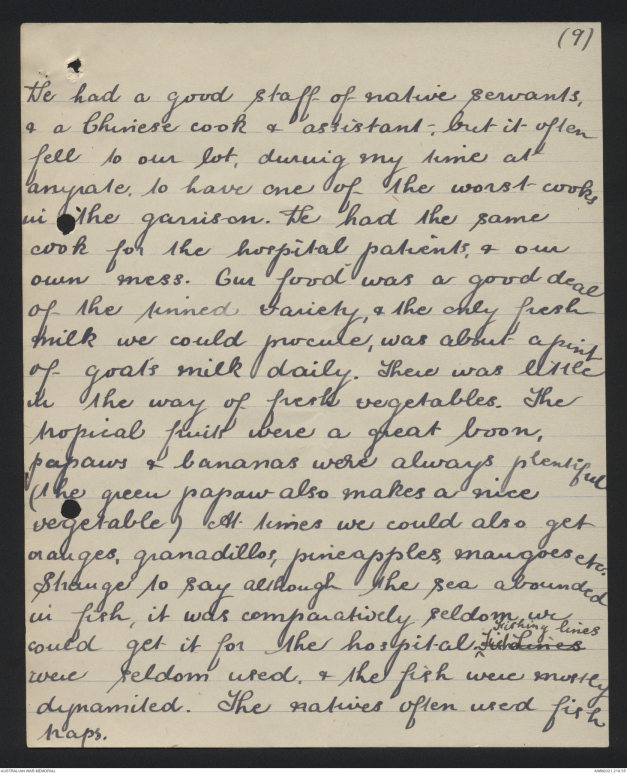
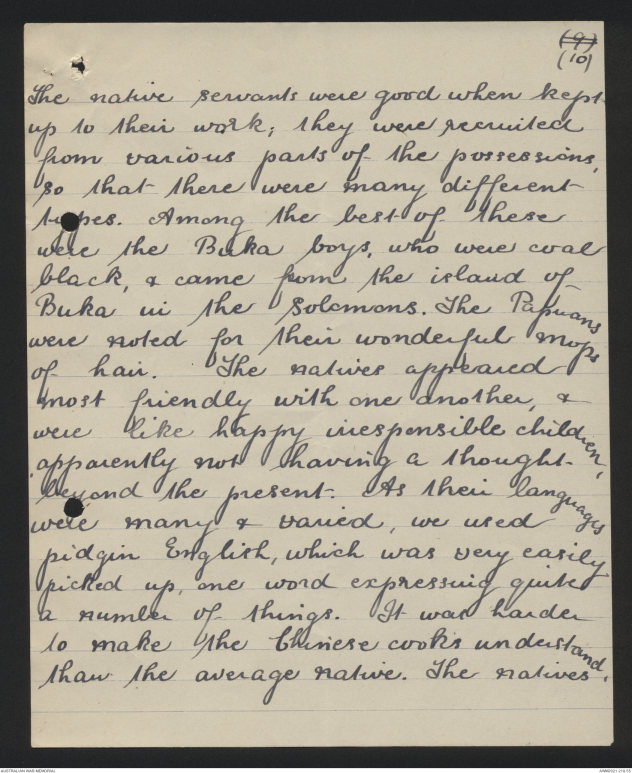
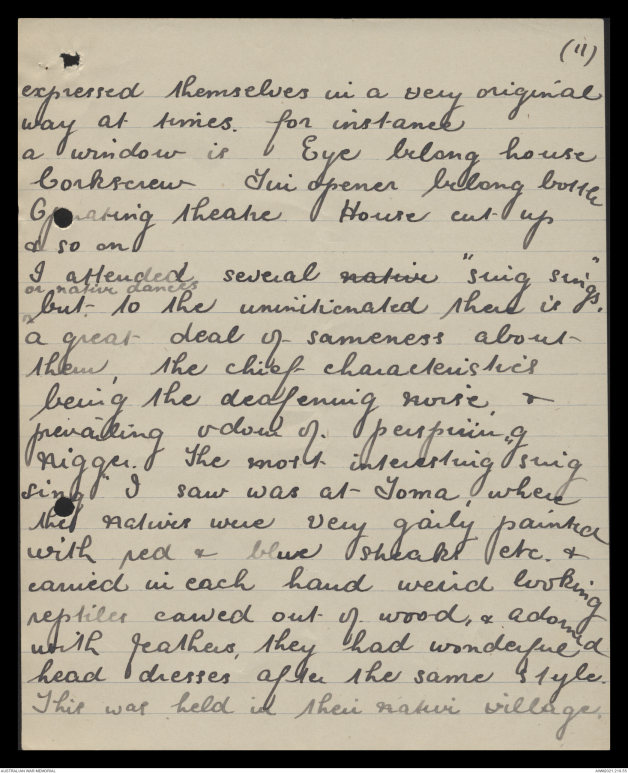

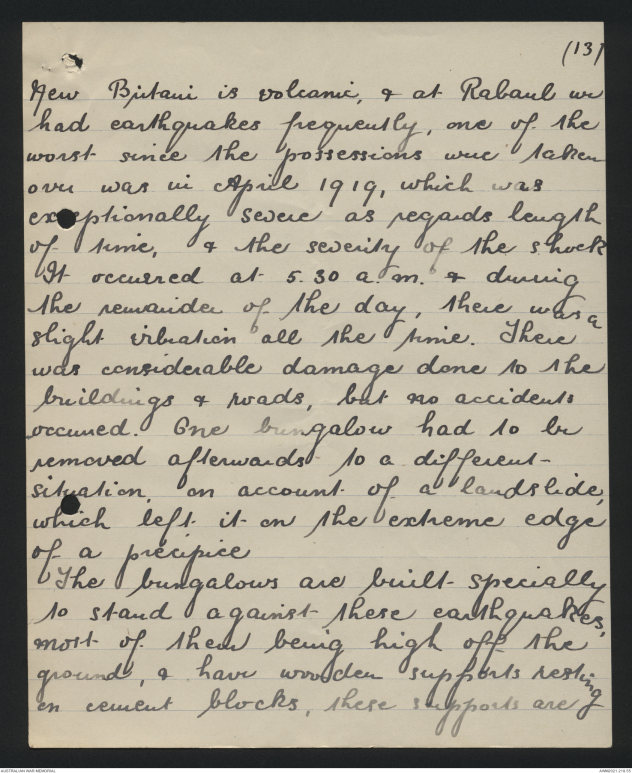
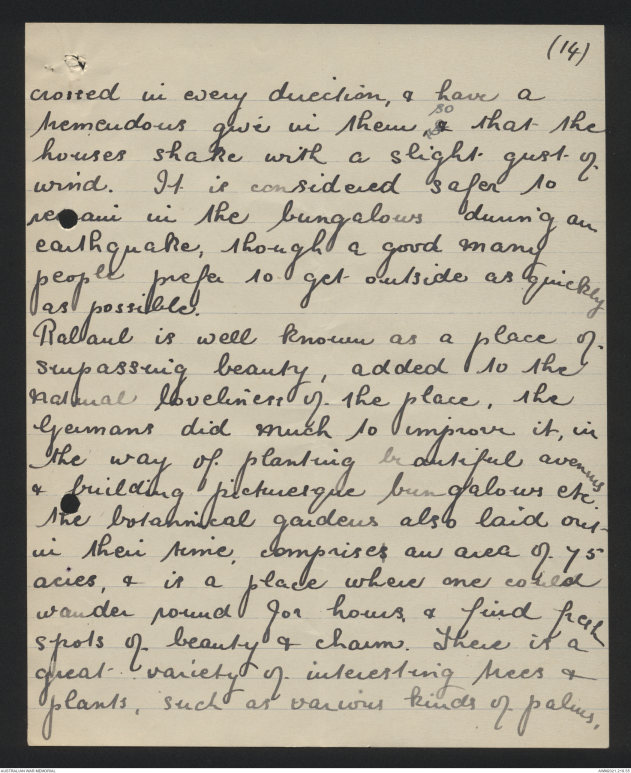

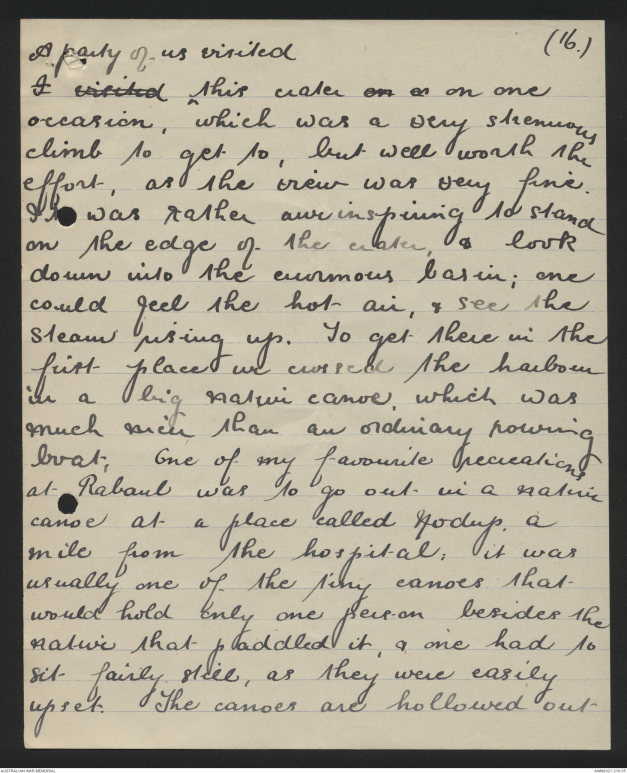


(9)
He had a good staff of native servants,
& a Chinese cook & assistant, but it often
fell to our lot, during my time at
anyrate to have one of the worst cooks
in the garrison. We had the same
cook for the hospital patients, & our
own mess. Our food was a good deal
of the tinned variety & the only fresh
milk we could procure, was about a pint
of goat's milk daily. There was little
in the way of fresh vegetables. The
tropical fruit were a great boon,
papaws & bananas were always plentiful
(the green papaw also makes a nice
vegetable) At times we could also get
oranges, granadillos, pineapples mangoes etc.
Strange to say although the sea abounded
in fish, it was comparatively seldom, we
could get it for the hospital ∧ fishing lines xxxxxx
were seldom used & the fish were mostly
dynamited. The natives often used fish
traps.
(9) (10)
The native servants were good when kept
up to their work, they were recruited
from various parts of the possessions.
so that there were many different
types. Among the best of these
were the Buka boys, who were coal
black, & came from the island of
Buka in the Solomons. The Papuans
were noted for their wonderful mops
of hair. The natives appeared
most friendly with one another, &
were like happy irresponsible children,
apparently not having a thought
beyond the present. As their languages
were many & varied, we used
pidgin English, which was very easily
picked up, one word expressing quite
a number of things. It was harder
to make the Chinese cooks understand
than the average native. The natives
(11)
expressed themselves in a very original
way at times. for instance
a window is Eye belong house
Corkscrew Tin opener belong bottle
G operating theatre House cut up
& so on
I attended several native "sing sings"
∧or native dances but to the uninitiated there is
a great deal of sameness about
them, the chief characteristics
being the deafening noise &
prevailing odour of perspiring
nigger. The most interesting sing
sing I saw was at Toma, where
the natives were very gaily painted
with red & blue streaks etc. &
carried in each hand weird looking
reptiles carved out of wood, & adorned
with feathers, they had wonderful
head dresses after the same style.
This was held in their native village.
(12)
The natives expressed delight when news
of the armistice came through, at hearing
that "English, he stop on top Germany
go finish," & gave a big "sing sing"
in honour of the occasion.
There was a hospital set apart for
the natives in Rabaul, but we sisters
had nothing whatever to do with it.
There were a couple of orderlies, & a
very good staff of native servants, who
did most of the work, with the A.M.C.
orderlies to supervise. A medical officer
was in charge, & to one interested in
tropical diseases, there would doubtless
be plenty of interesting work.
(13)
New Britain is volcanic, & at Rabaul we
had earthquakes frequently, one of the
worst since the possessions were taken
over was in April 1919, which was
exceptionally severe as regards length
of time, & the severity of the shock
It occurred at 5.30 a.m. & during
the remainder of the day, there was a
slight vibration all the time. There
was considerable damage done to the
buildings & roads, but no accidents
occurred. One bungalow had to be
removed afterwards to a different
situation on account of a landslide,
which left it on the extreme edge
of a precipice
The bungalows are built specially
to stand against these earthquakes,
most of them being high off the
ground, & have wooden supports resting
in cement blocks, these supports are
(14)
crossed in every direction, & have a
tremendous give in them ∧so xx that the
houses shake with a slight gust of
wind. It is considered safer to
remain in the bungalows during an
earthquake, though a good many
people prefer to get outside as quickly
as possible
Rabaul is well known as a place of
surpassing beauty, added to the
natural loveliness of the place, the
Germans did much to improve it, in
the way of planting beautiful avenues
& building picturesque bungalows etc
The botanical gardens also laid out
in their time, comprises an area of 75
acres, & is a place where one could
wander round for hours & find fresh
spots of beauty & charm. There is a
great variety of interesting trees &
plants, such as various kinds of palms,
(15)
species of rubber, cocoa, capok, coffee
etc. There is a charming avenue of
bottle trees leading up to the residence
of the G.C. botannical gardens, which
is one of the prettiest spots in
Rabaul.
Rabaul is situated at the foot of
Mt. Mother, some 2,000 odd feet in
height, & is one of a chain of
mountains, ending in Mr. Father,
some miles down the coast of
New Britain, the latter is an active
volcano. One can see many
remains of old craters from Rabaul,
coming up Blanche Bay, there is a
very good view of one of these,
which presents rather a weird appearance,
with its edge broken down
towards the sea, & one can see
yellow streaks of sulphur on it.
We could often smell the sulphur very
distinctly from Namanula.
(16)
A party of us visitedI visited this crater on a on one
occasion, which was a very strenuous
climb to get to, but well worth the
effort, as the view was very fine.
It was rather awe inspiring to stand
on the edge of the crater, & look
down into the enormous basin; one
could feel the hot air, & see the
steam rising up. To get there in the
first place we crossed the harbour
in a big native canoe, which was
much nicer than an ordinary rowing
boat, One of my favourite recreations
at Rabaul was to go out in a native
canoe at a place called Nodup. a
mile from the hospital, it was
usually one of the tiny canoes that
would hold only one person besides the
native that paddled it, & one had to
sit fairly still, as they were easily
upset. The canoes are hollowed out
(17)
logs & have an out rigger built on one
side, so that if upset they don't
sink. It was like a kind of fairyland
to look through the deep blue water,
which is as clear as glass, & see the
coral below, all kinds of wonderful
colours, & varied shapes, & the most
beautiful jewelled fish darting in &
out amongst it, the most lovely were
tiny blue fish about an inch long.
the star fish also were very lovely
some red & others blue, but lost
their beautiful lustre when taken
out of the water
Unfortunately the sharks were too
numerous to go in much for swimming
but we did bathe sometimes in
the hot springs near Malupi; the
water is boiling hot in places, showing
the volcanic nature of the country
(18)
Other favourite recreations were riding
& tennis. A motor drive was always
a treat. The military cars were only
used for administrative purposes,
but we were allowed one, if we
wished to do shopping in Rabaul.
Occasionally had the chance of a
drive to Tokopo, when some of
the officers had business which
took them there, & were kind
enough to take a sister or two
with them. Kokopo is about 20
miles from Rabaul & up till 1910
was the German seat of government
called Hebertshor in their time.
The drive there from Rabaul is
one of the most beautiful one could
wish for; everywhere there is the
wild profusion of the tropical
vegetation, & at times one gets a good
view of the harbour through the coconuts
& other palms, banana plants etc.
 Sam scott
Sam scottThis transcription item is now locked to you for editing. To release the lock either Save your changes or Cancel.
This lock will be automatically released after 60 minutes of inactivity.